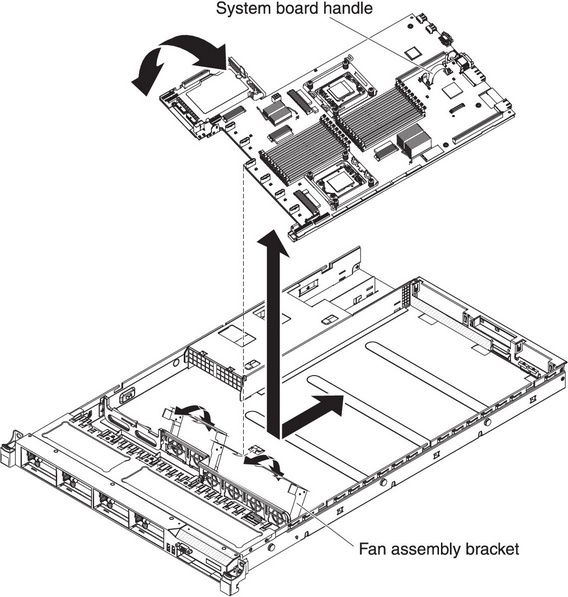Use this information to remove the system board.
To remove the system board, complete the following steps.
- When you replace the system board, make sure that you remove the virtual media key and place it on the new system board. For information about the location of the key, see Removing the virtual media key.
- When you replace the system board, you must either update the server with the latest firmware or restore the pre-existing firmware that the customer provides on a diskette or CD image. Make sure that you have the latest firmware or a copy of the pre-existing firmware before you proceed.
- Read the safety information that begins on Safety and Installation guidelines.
- Turn off the server and peripheral devices and disconnect the power cords and all external cables.
- Remove the cover (see Removing the cover).
When you replace the system board, you must either update the server with the latest firmware or restore the pre-existing firmware that the customer provides on a diskette or CD image. Make sure that you have the latest firmware or a copy of the pre-existing firmware before you proceed.
- Pull the power supplies out of the rear of the server, just enough to disengage them from the server.
- Remove all PCI riser-card assemblies and adapters (see Removing a PCI riser-card assembly).
- Remove the SAS/SATA RAID riser-card assembly (see Removing the SAS/SATA RAID riser-card assembly).
- Remove the microprocessor 2 and DIMM air baffles from the system board (see Removing the microprocessor 2 air baffle and Removing the DIMM air baffle).
- (Trained service technician only) Remove all heat sinks and microprocessors, and set them aside on a static-protective surface for reinstallation (see Removing a microprocessor and heat sink).
- Remove the socket covers from the microprocessor sockets on the new system board and place them on the microprocessor sockets of the system board you are removing.
- Do not allow the thermal grease to come in contact with anything, and keep each heat sink paired with its microprocessor for reinstallation. Contact with any surface can compromise the thermal grease and the microprocessor socket. A mismatch between the microprocessor and its original heat sink can require the installation of a new heat sink.
- Remove the memory modules and set them aside on a static-protective surface for reinstallation (see Removing a memory module).
Make a note of the location of each DIMM as you remove it, so that you can later reinstall it in the same connector.
- Remove the virtual media key from the system board and set it aside. You will have to install the virtual media key on the new system board.
- Remove the system battery (see Removing the system battery).
- Disconnect all cables from the system board (see Internal cable routing and connectors). Make a list of each cable as you disconnect it; you can then use this as a checklist when you install the new system board.
Disengage all latches, release tabs or locks on cable connectors when you disconnect all cables from the system board. Failing to release them before removing the cables will damage the cable sockets on the system board. The cable sockets on the system board are fragile. Any damage to the cable sockets may require replacing the system board.
- Remove the hot-swap fans (see Removing a hot-swap fan assembly).
- Press the fan brackets release latches (one is to the left of fan 6 and one is to the right of fan 1) inward toward the fans and rotate the fan assembly brackets up toward the front of the server.
- Grasp the system board handle and lift up the right side of the system board slightly so that it disengages from the locator pin; then, slide the system board slightly toward the left of the server.
Figure 1. System board removal
- Lift up the system board and carefully remove it from the server, being careful neither to damage any surrounding components nor to bend the pins inside the microprocessor sockets.
- Remove the socket dust covers from the microprocessor sockets on the new system board and place them on the microprocessor sockets of the old system board that you are removing.
Make sure to place the socket covers for the microprocessor sockets on the system board before you return the old system board.
If you are instructed to return the system board, follow all packaging instructions, and use any packaging materials for shipping that are supplied to you.
